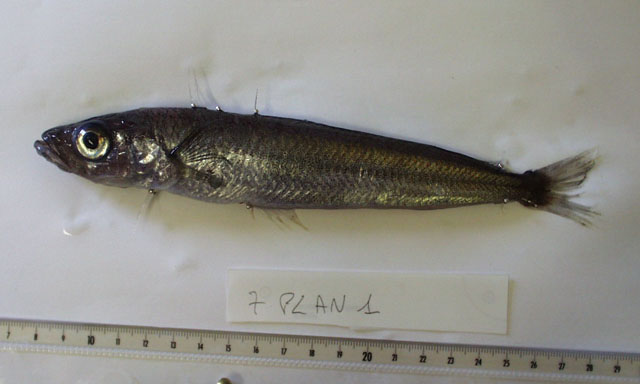| Nototheniidae (Cod icefishes), subfamily: Pleuragrammatinae |
| 26.6 cm TL (male/unsexed); max.weight: 200.0 g; max. reported age: 20 years |
|
pelagic-oceanic; marine; depth range 0 - 1000 m |
| Southern Ocean: Antarctic Peninsula, South Shetland, Elephant, South Orkney islands, Weddell, Bellingshausen, Ross and Davis seas, Oates, Adélie, Wilhelm and other coasts of East Antarctica to Prydz Bay. |
|
Dorsal spines (total): 6-8; Dorsal soft rays (total): 35-38; Anal spines: 0-0; Anal soft rays: 36-39; Vertebrae: 52-56. Pre-opercular-mandibular canal pores 9 (rarely 10), with 3 (rarely 4) on the mandible. Infraorbital canal with 4+2 pores; lateral line organs (neuromasts) present exposed region between the canal segments, the normal number probably being 4 (rarely 5), but some or all are often missing. Supraorbital canal with 3+1 pores (a second, more posterior pore rarely present in postero-dorsal section); between these 2 supraorbital canal segments is a trough divided by 3 low transverse ridges into 4 shallow depressions; on each ridge is a neuromasts organ. Temporal canal with 1+4 pores; between the 2 segment lies a single exposed neuromast. Supratemporal canal with 1+1 pores; no traces of neuromasts were found in the intervening regions.
Color: In life, pink with a silvery hue, the dorsal surface slightly darker. All fins pale, with clear hyaline membranes. The body becomes silvery with a darker dorsum only after death (Ref. 28937). |
| Regarded as the only truly pelagic fish in Antarctic waters (Ref. 6390). Larvae and postlarvae occur between 0 to 135 m; juveniles 50 to 400 and adults below 400 m (Ref. 5179). Postlarvae feed mainly on eggs and larvae of copepods; juveniles mainly on copepods, but take also eggs and larvae of euphausiids, polychaetes and chaetognaths (Ref. 5179). Larger items are ingested with increase in size (Ref. 5179). Larval pelagic phase is long (Ref. 28916). |
|
Least Concern (LC); Date assessed: 04 February 2009 Ref. (130435)
|
| harmless |
|
Source and more info: www.fishbase.org. For personal, classroom, and other internal use only. Not for publication.

